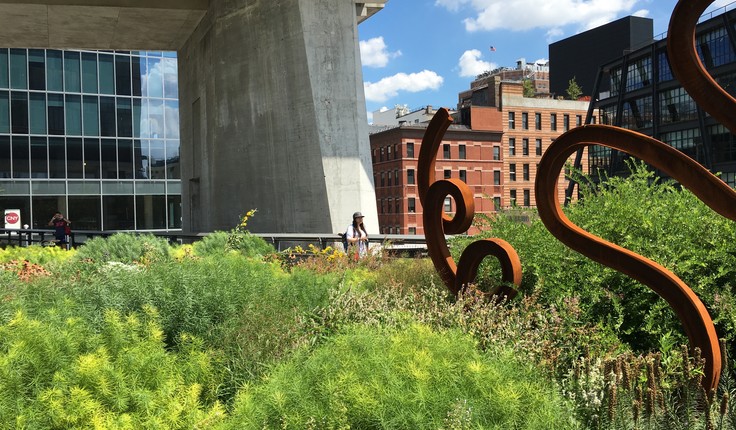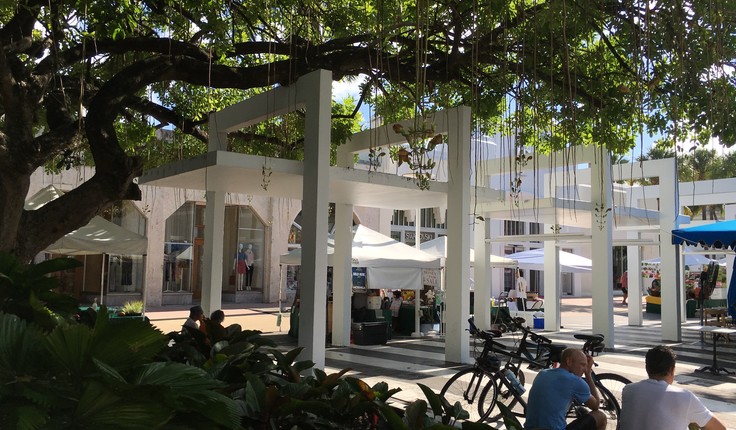News
Coffee, professional encroachment and the art of planting design
Posted 28 02 2017 by Craig Pocock
in News

A good friend, mentor and one of the early founders of landscape architecture in New Zealand Earl Bennett once lamented over coffee, that planting design was one of the few skills left to landscape architects that was not under aggressive encroachment from other professional design disciplines. He felt that so much of the traditional landscape architecture work was being taken by architects, engineers, surveyors, planners and the all-invasive “urban designer”. He was frustrated that so few students cared about plants or planting design and felt that planting design education needed to be focused on.
At the time, I felt he had an interesting point that I had not considered before, mainly because I had been too busy fighting off architects, surveyors and engineers who wanted to design streetscapes and open spaces. In many ways landscape architects should take this design encroachment as a compliment as the general design industry wiggles their way into the traditional design realm of the landscape architect, we are clearly doing cool stuff now days and everyone wants a piece of the action.
However as Earl points out, landscape architects still have one skill that is unlikely to be challenged anytime soon by the architects and engineers and one we should be proud of and that is planting design. I want to explore how we learn planting design and in particular the reluctance of landscape architectural students and recent graduates to engage in or hone their skills in this art.
The role of the education provider.
In a survey that the NZILA ran in 2015 as part of an education standards review, one of the top three concerns that came back from the industry study was that students were not coming into the market with planting design skills. This concern in the lacking of planting design skills was consistent across both large and small landscape architectural practices. The study was valuable because it gave students an idea of what their future employers would be looking for and arguably some direction for the education providers. It also informed the new NZILA educational standards and requirements.
When talking to education providers about landscape architecture skills in the past, such as planting or computer programs, I have heard the argument that it’s not solely their job to teach these skills but is a shared responsibility with industry. Their role is to teach and produce opened minded well round graduates who can research solutions and be independent thinkers, “they don’t need to know the solutions they just need to be able to find them”. To me this feels like a certain amount of economic rationalization going on and worried about the google culture being applied to design and planning skills. I think there are some skills that you just have to practice in a repetitive design studios and planting design skills falls into this category for me. .
Over the last fews years I have found graduates that I have employed trying to google their way out of basic design problems. Somehow search engines are being used to fill the gap for a lack of basic design knowledge, and if they can't find the answer fast they stop looking or the first answer they find is considered the right one. I agree research skills and an open mind are important to have as a graduate but can’t come at the cost of focused studio design practice, especially when it comes to planting design.
I also understand from 10 years of teaching in NZ that it is important to note the institutions do have a limit on resources and hours in which to product a graduate and that they can’t cover every aspect of landscape architecture in detail. Institutions are under constant pressure to increase course contents for example the recently increased requirement for Maori values within the landscape to be included and has to come at a cost, the the hours to teach this has to come from somewhere. However, in my opinion and experience, we still have the majority of students coming into the industry with average planting design skills at best. Good planting design skills still feels like it should be a core requirements skill for a graduate and maybe its time we review how it is taught.
Reconsidering how planting design is taught.
It has been more than two decades since I was at design school and in those days we had to do planting designs in plan form, which required neat pen work. Yes we used those horrible ink pens on velum that required a razor blade to scrape a mistake off the page. In hindsight drawing plans was a messy, time consuming process and maybe not the best way to teach design, especially planting design.
Jump forward to 2005-2016 and students we are still doing planting design in plan form, granted with computers programs and no inky fingers but the thinking has not changed. I don't believe plans are the best way to understand design, People do not experience space or planting in the environment in plan form. Plans are documents used for construction and have limited design value especially at the conceptual stage and yet we continue to teach planting design in plan form.
In the years of teaching students, all the studio projects that I was involved in had students produce planting plans, often these plans were required in the final stage of a studio project and the students would knock them out on the last night resulting generally in a pretty low level of design consideration. The lack of design consideration did not generally matter to the students because the percentage mark allocation for the planting plan was low, by this stage they generally knew if they were passing or not. The planting plan became a produceable not a design study.
In my experience students struggled to think about the role of the planting in their design, how it would look through the seasons or how it would be experienced by the community. Most of their energy would go into the process of drawing the plan not developing a great planting approach for their project. I suspect that often they just drew circles and dots to fill up the garden plots and then picked the plant names later from the local DOC list or plant catalogues with no real design consideration.
I base these observations on many studio conversations I had with the students, leaning over their planting plans asking questions such as; “do you know what this plant actually looks like, why are the tall plants at the front of the garden and the low plants behind, why are there no amenity plants under the tree canopy circle” and so on. There was often little understanding of the cultural requirements of the plants as well as of the aesthetic function in spatial definition, little practical considerations to shelter, shade, and screening. Generally the end result was the same over the years, native plants on massed to fill in the space between paving and a building edge, they ticked the “produce a plan” box and moved on.
It is important that a student by the end of their education know how to draw a planting plan for contract documentation but that is not the same as learning planting design. It maybe worth considering having students learn planting design by other means other than drawing plans such as but not limted to plant design studies that sketch out what the final design will look like.
The fastest ways to do these studies is cross sections and perspectives and there purpose is to test a planting design in three dimensions with consideration to seasonal variation, colour and texture. Students should be testing their designs and plant selection to make sure it performs visually in the way it is expected and to show how the planting integrates into the overall design.
With technology there are many fast and easy ways of doing this like printing a 3D model view similar to what a person might experience in the landscape and then draw the planting design overtop. Use an iPad and photograph an existing landscape and then put tracing paper over top of the iPad and trace out the proposed planting design on the screen as a fast and easy test. These perspective design tests are useful and for not only testing the planting design and understanding how it will perform but they are also valuable for showing clients what they are going to get. Most clients get excited seeing hand drawings compared to plans which many can’t read. Its a great way to learn design and develop confidence in drawing which is valuable tool in a design career.
My advice is when its comes to planting design and teaching it “step away from the computer” or plan based design method and teach planting design by engaging in hand drawing and three dimensional design studies. This is a value skill that I think this could be taught from the first year at design school onwards and should be applied into continuing professional practice courses.


Planting design as a connection between the education providers and the Industry.
In the last 10 years I have employed at least 30 landscape architects, some students on work experience others permanent staff including internationally trained landscape architects. To my frustration few of them were interested in planting design or understood how to prepare a planting plan. They had little appreciation for how planting design could strengthen an overall design approach and they would avoid doing planting design if possible. It is interesting to note that this lack of engagement in planting design is not just a New Zealand problem, as I employed some European and American trained landscape architects as well.
Planting design is often one of the early forms of design that you give a graduate to do because it is a good “low risk” way for a firm to teach design approaches, graphics and digital draughting standards. It is understandable that the industry would be frustrated if graduates lack the basic planting design skills, it makes employing them harder and more costly.
It is important that even the first year students learn that planting design is a valuable part of the landscape architect’s tool kit whether it being large scale restoration planting or a plant selection for a streetscape. If students during their studies develop good planting design skills it makes it easier for firms to provide students with the work experience they require to graduate. Planting design is an important interface between the design industry and the students and hence needs to be prioritised early in the education process.
The role of the industry.
I think the disengagement in planting design is not just a reflection on education, it is also a reflection on the industry and what we reward. Can we blame students for dreaming of their first big job placement being in a “cool hip” design firm that focuses on urban design and streetscapes when that is what they see predominantly being rewarded in our industry?
Its not hard to see what we value in the NZILA when you review our publications, website and past awards. You will find plenty “award wining and celebrated” projects in our publications, sweeping vistas of Auckland and Wellington, streetscapes veneered with grey stone paving, minimalist street furniture design, clever word street art, oh and the occasional Nikau or Pohutukawa in the back ground. very seldom do the images show how planting plays an important role in these spaces. How could you, as a student, not lust after this type of urban design portfolio and why would you think plants were important? It almost defines what success should look like as a landscape architect and its very urban. I am sure it is hard as a student to look at these multi million dollar urban streetscapes and harbour edges and then look at a cleverly designed riparian planting or local reserve and get the same feeling of “wow”.
As an industry we tend to give more coverage to the slick urban and not celebrate our professional diversity and so it is understandable that students now have defined landscape architecture as the urban realm and relegated planting design to the backroom. As for landscape assessment and planning, it does not even make the backroom, in my experience you would be lucky to find 1 in 100 students who during their studies want to focus on landscape assessment or planning. There is certainly as article on this subject alone, but I will leave that for others.
I understand the above all sounds like pure opinion however in the last ten years of teaching final year landscape architect students I would ask the students two questions; “What type of work did they hope to work after graduation and how much did they think they would get paid”? The answers where pretty consistent, students mainly wanted to do urban design work, big city work with big budgets. Very few wanted to do residential work and almost none wanted to do planning and assessment work. They generally wanted to start at the $60-70,000 per annual mark to offset the cost of their course however few students had every looked into pay rates for landscape architects before picking the career. I guess I must have asked these two questions to over 500 student over the last 10 years and after asking the questions would give advice on how you might get to those firms and how that might influence a major design site selection. It was always interesting to me how similar each year groups answer were.
The student’s answers showed a clear misfit in aspiration verse information considering New Zealand has few cities of scale with the majority of work in New Zealand in the field of landscape management, assessment, planning, I could understand this urban focus if they were studying in New York . There are few firms actually doing urban design with any consistently and from my experience urban design work carried the highest risk factor and lowest fee to hour ratio of any of the design categories. Ironical in my experience landscape assessment paid the most fees with the lowest risk and students are not interested in this type of work.
I think there maybe value in having more industry interface within the education process so students can get a better understanding what the industry wants and the job market offers so that the student can make informed course decision during their education. This would require the industry to engage and support the education providers even if there is is little or no fees to be had.
Over the last 10 years teaching its been a pleasure working with teaching staff but it is hard not to notice the same familiar consultant faces year after year and which firms have been missing from the studios and general education process. If firms care about the future of the industry and don't just see the institutions as simply labour providers then they have to start investing more in the next design generation and there education.
Celebrate planting as an integrated part of what we do.
As mentioned in the opening paragraph, planting plans are unique to landscape architects, certainly within the urban realm and it strengthens our position at the design table when we are proficient in this area. Earl’s observation that planting design needs to be taught with a passion and honed with continuing professional development within our industry is not only correct but important to our professional identity. We need students to engage early and meaningfully in the study of planting design using a range of methods that truly test the role of plants within our designs and environment.
We also need to openly celebrate the environmental and community values that great planting design contribute to our projects, within our awards, publications and NZILA website. It does not mean we don’t continue to celebrate our urban projects the the thought leaders in this area, we just need to widen our design world view a bit more and bring in some more diversity.
I have often noticed at public meetings on street or public space upgrades that the community often references the existing plantings and trees as the most important and values elements to protect or retain, not the paving, furniture or arty light posts. Maybe our clients and communities have a better appreciation for something that we ourselves are not good at acknowledging, that good planting design is valuable and has a lasting positive effect on a community’s well being.
Craig Pocock
NZILA Registered Fellow
February 2017
Share
19 Dec
Christmas break 2025

see you from 12 January
As we wrap up another big year, we’re taking a moment to pause, breathe, and enjoy a well-earned break. Meri …
18 Dec
President’s update

December 2025
Earlier this month I attended the Ngā Aho Māori Design Professionals Wānanga-ā-Tau at Te Aranga Marae in Flaxmere. Tuia Pito …
18 Dec
Awards 2026 update

An update as we warm up for the 2026 Awards kaupapa. Submissions will open in March and will run for …
Events calendar
Full 2026 calendar